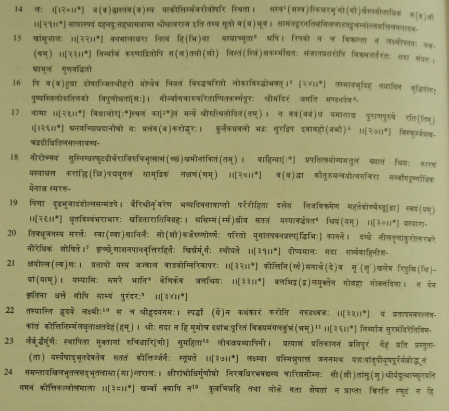| |
North
Indian Inscriptions |
| |
|
|
|
INSCRIPTIONS OF THE PARAMARAS OF VAGADA

___________________________________________________________
[1] Originally स्वा with the sign of mātrā erased so lightly as to leave its mark on the stone.
[2] Here Barnett read yasy-āchyasā and called it corrupt. He also stated that the translation of Gopal
Lal Vyas gives achyuta suits the sense well but does not seem to be the reading from the ink-impression. My reading is as transcribed here and Vyas appers to have prepared his reading from the original
stone. The pun on expressions used in this suggests that his enemies had disappeared in dharā, i.e.,
land which had a line of mountains.
[3] This daṇḍa is followed by a rosette and another daṇḍa.
[4] Here is a kāka-pada symbol showing that the word is continued in the next line.
[5] The double meanings of the words dāna. kara and dhavala are intended to show that the king resembled
India’s elephant.
[6] Originally, त:, with the sign of visarga erased later on. The third akshara in khaṇḍitārāti that precedes
in the same line is engraved in smaller letters just below where it is required.
[7] This daṇḍa is superfluous.
[8] Engraved as भां-, with the sign of anusvāra erased but leaving a clear mark.
[9] The words used here with double meanings intend to show that the king excelled Indra, who is known
to have killed the demon Bala and cut the wings of mountains (gōtras).
[10] The sign of visarga, which was first omitted, was inserted subsequently.
[11] The expressions here show that the king was identical with an auspicious bowl. The custom of adoring
an auspicious jar with foliage and grains is well known.
[12] That is, well (much) esteemed.
[13] Engraved नु, with the mātrā erased. This states that the king excelled all the incarnations of
Vishṇu, namely, those of Vāmana, Balarāma, Buddha, Krishṇa, Matsya and Varāha, respectively; and
what is more is that his fame was of white colour in contrast with that of dark body (kṛishṇāṁ tamaṁ) of
the lord of Lakshmī. This is not suggested by Barnett’s translation. The figure of speech is Vyatireka,
showing that the body of this king was not dwarf as of Vamana, and so on.
...................CORPUS INSCRIPTIONUM INDICARUM
VOL.VII ........................................................................PLATE LXXXIV
.ARTHUNA STONE INSCRIPTION OF CHAMUNDARAJA : (VIKRAMA) YEAR 1136

|
\D7
![]()
|









